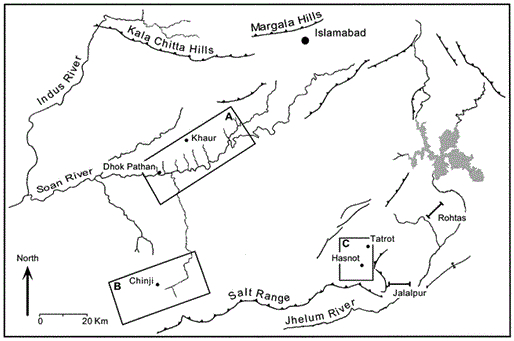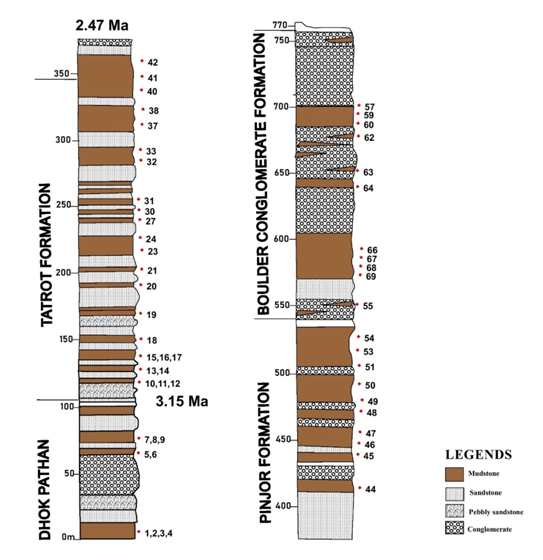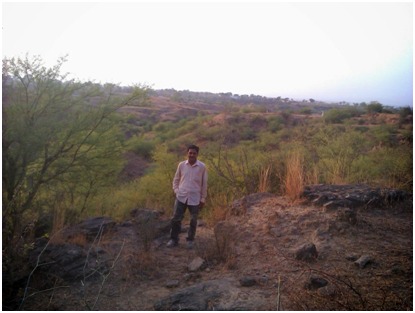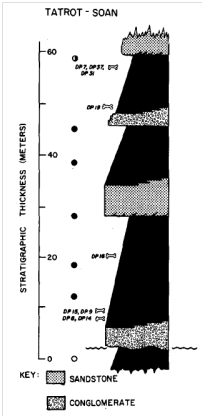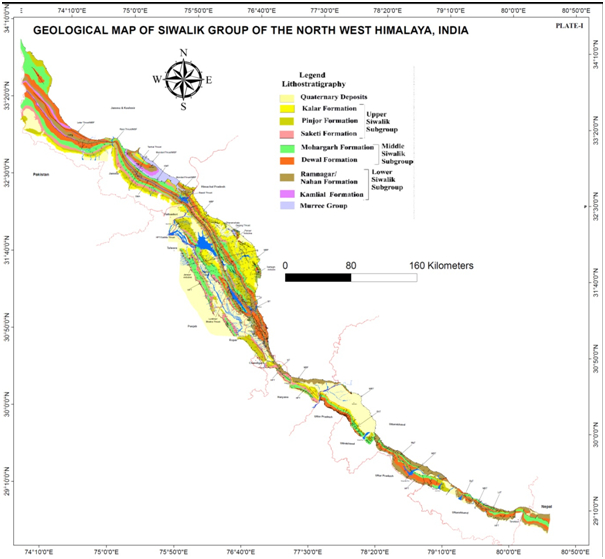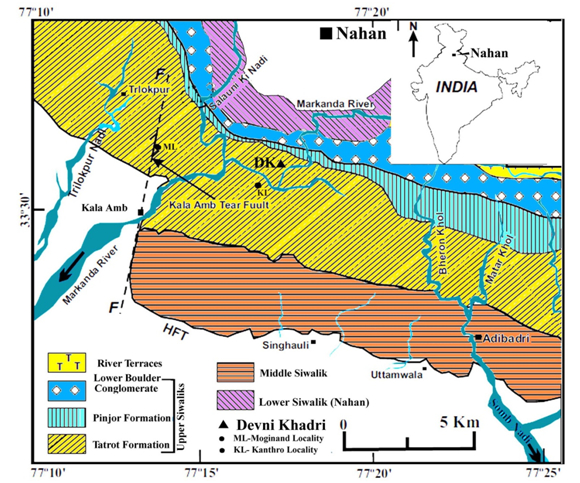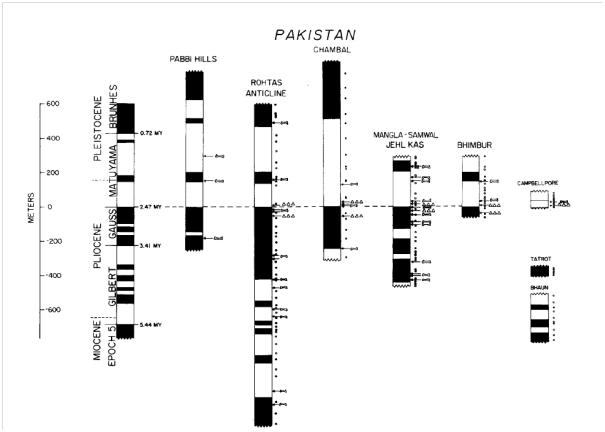Tatrot Fm
Type Locality and Naming
Named after Tatrot Village in Pakistan. Type section is in Tatrot. Its thickness in type section is ~ 60 m. [Original Publication: Pilgrim, G.E. (1910): Preliminary note on a revised classification of the Tertiary freshwater deposits of India. Records of Geological Survey of India, 40(3): 185-205; Pilgrim, G.E. (1913). Correlation of the Siwaliks with Mammal Horizons of Europe. Records of Geological Survey of India, 43 (4): 264-326; Pilgrim, G.E. (1938). Are the Equidae reliable for the correlation of the Siwaliks with the Cenozoic stages of North America? Records of the Geological Survey of India, 73(4), 437-482]. Reference section: Markanda River Section, Saketi with 48 (20 marker) mammalian taxa (Nanda, 2015). Its thickness in reference section is 250 m.
Synonyms: ‘Tatrot Stage’ (Sahni and Khan, 1964), Masol Member (Pandey, 1971), pre-Pinjor beds (Nanda, 1981), Dhamala Fm (Sastry, 1981), Labli Member, Uttarbaini Fm (Gupta and Verma, 1988), Parmandal Sandstone (Ranga Rao et al., 1988), Saketi Fm (Nanda, 2015).
[Figure 1: Map of the Potwar Plateau in northern Pakistan, showing the locations of regional networks of stratigraphic sections along the Soan River (A), on the southern limb of the Soan Synclinorium near Chinji (B), and at the eastern end of the Potwar Plateau near Hasnot (C). The location of sections at Jalalpur and Rohtas are also shown. Barbed lines denote the boundaries of thrust sheets. Grey stippled area to east is a reservoir (source: Barry et al., 2002)]
[Figure 2: Litholog of Markanda River section with sample positions (modified after Verma and Verma 1969)]
Lithology and Thickness
Sandstone to siltstone. Fine-, medium- and coarse-grained grey sandstones, variegated mudstones and siltstones.
Lithofacies: Pebbly sandstone facies (St), Medium- to coarse-grained sandstone facies (St-Sp facies); Bioturbated calcareous fine-grained sandstone facies (FI facies); Parallel-laminated bioturbated mudstone facies (Fsc facies); Brown pebbly mudstone facies (Fm facies) (Kumar and Tandon, 1985)
[Figure 3: Tatrot Formation outcrops near Tatrot, Pakistan (source: http://paleontologypakistan.blogspot.com/2015)]
[Figure 4: Stratigraphy of the Tatrot Type section (Opdyke et al., 1979)]
Relationships and Distribution
Lower contact
Gradational contact with the underlying Dhok Pathan Fm (Verma, 1989).
Upper contact
Tectonic contact with the overlying Pinjor Fm.
Regional extent
[Figure 5: Geological Map of Siwalik Group, modified after Eliyas et al. (2016)]
[Figure 6: Geological map of the area showing the fossil site (modified after Srivastava et al., 1988). The lower part of the Kala Amb Section has been palaeomagnetically dated by Azzaroli and Napoleone (1982)]
GeoJSON
Fossils
[Table 1: Mammalian taxa in the Saketi (=Tatrot beds, =pre-Pinjor beds of the Upper Siwalik Subgroup) and Pinjor beds of Chandigarh region (based on collection of last five decades, modified after Nanda, 2002, 2013, 2015; Raghavan et al., 2007; Patnaik, 2013; Jukar et al., 2018; 2019)]
Saketi Formation (=Tatrot Formation)
LIPOTYPHLA (=INSECTIVORA): Suncus cf. S. murinus
RODENTIA: Palaeomys sp., Miorhizomys (=Brachyrhizomys) pilgrimi , Rhizomyides saketiensis, R. cf. R. sivalensis, R.(=Brachyrhizomys) punjabiensis, Mus flynni, M. jacobsi, Hadromys primitivus, H. moginandensis, Cremnomys cf. C. cutchicus, Bandicota sivalensis, Protatera cf. P. kabulense, Golunda tatroticus, Dilatomys moginandensis, Abudhabia cf. A. kabulense, Parapelomys robertsi, cf. P. robertsi
LAGOMORPHA: Pliosiwalagus whitei
CARNIVORA: Saketoteron tatroinse
PROBOSCIDEA: Anancus (=Pentalophodon) khetpuraliensis, Stegodon bombifrons
PERISSODACTYLA: Cormohipparion” (Sivalhippus) theobaldi, ?Hipparion antelopinum, Hipparion sp., Plesiohipparion huangheense, Eurygnathohippus ?Rhinoceros sp.
ARTIODACTYLA: Merycopotamus dissimilis, Potamochoerus prasadi, Hippohyus lydekkeri (=H. tatroti), Sivachoerus prior, Hydaspitherium megacephalum, Proamphibos kashmiricus, P. lachrymans, Probison dehmi
[Figure 7: Occurrence of individual fossil species based on magnetostratigraphy (Opdyke et al., 1979)]
[Figure 8: Range of stratigraphically important taxa in the Plio-Pleistocene of the Siwalik (Opdyke et al., 1979)]
Age
Depositional setting
The characteristic fluvial sandstone/mudstone cycles suggest well developed meandering regime; laterally migrating stream channel in association with a trailing floodplain. In general a coarsening upward sequence is observed. The finer mudstone facies suggest deposition in flood-plains as over bank facies under low energy alluvial environments. Alternate grey bedded to cross-bedded sandstones indicate fluvial deposits under high energy and warm climate conditions. Channel deposits with secondary development of concretions indicates semi-arid climate. Variegated nature of mudstone may indicate seasonal variation in deposition. The calcareous nodules and concretions in sandstone and mudstone appear to have formed under arid/semi-arid to humid conditions. Paleosols and iron concretions support the existence of warm and humid climatic conditions. Paleosols that shows mottling, alterations of color from brown siltstone to light greyish green color may indicate water logged and reducing environmental conditions (Kumar et al., 2012).
Additional Information
[Figure 9: Paleomagnetic correlation of the Upper Siwalik stratigraphic sections of northeast Pakistan (Opdyke et al., 1979)]
